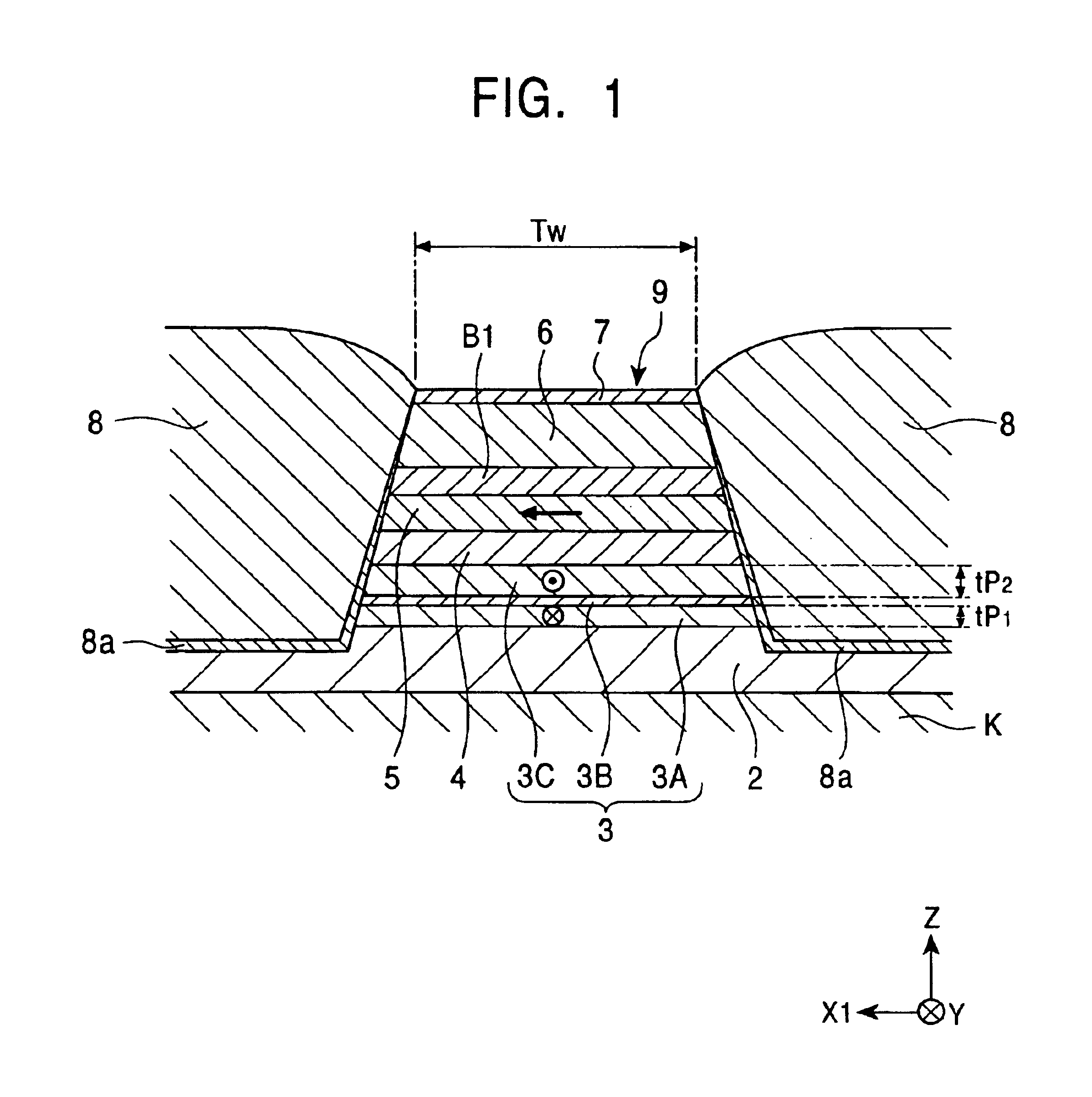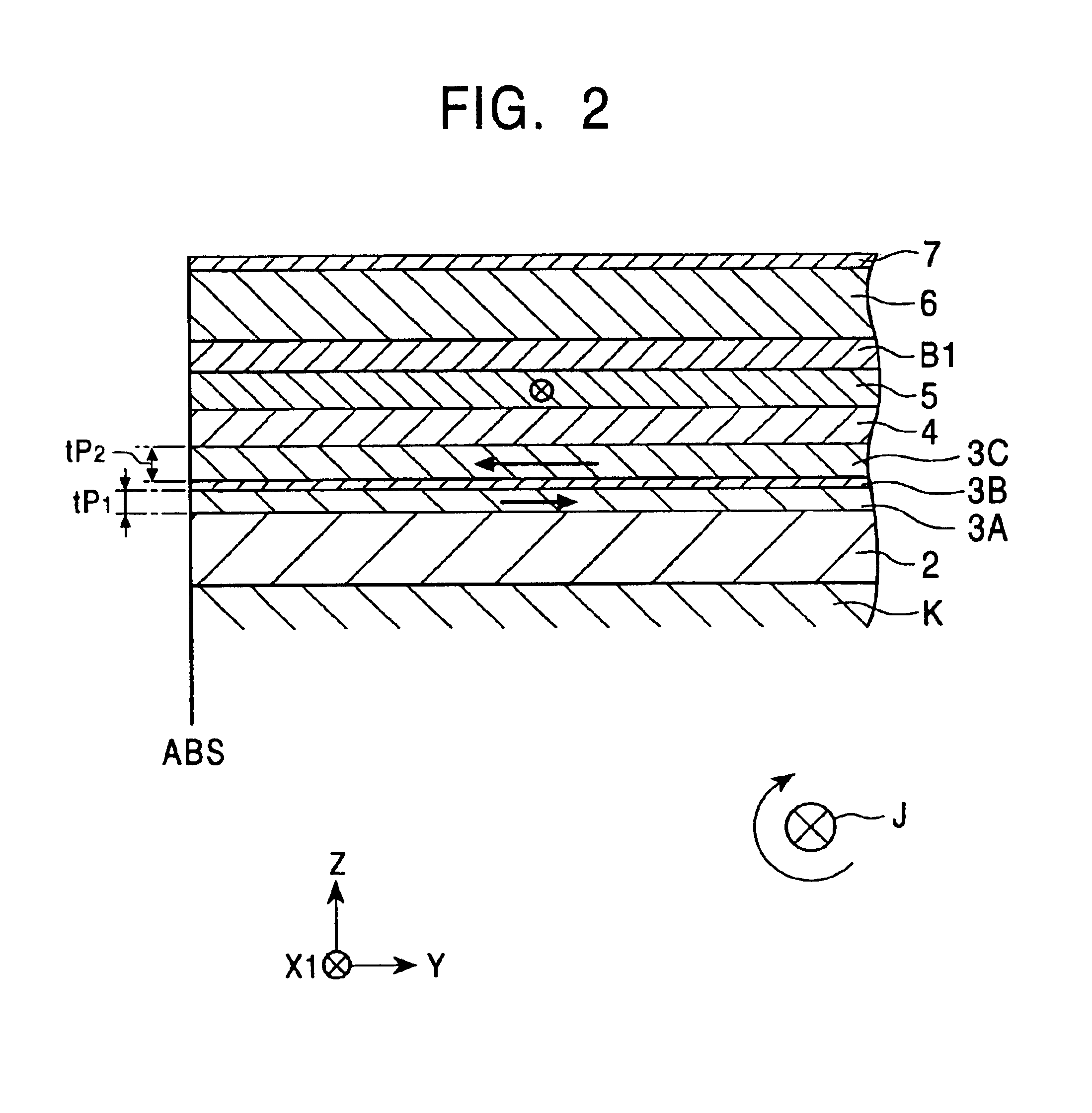Spin-valve thin-film magnetic element and method for making the same
a thin-film magnetic element and spin-valve technology, applied in the field of spin-valve thin-film magnetic elements, can solve the problems of reducing the detection sensitivity, difficult to precisely define the effective magnetic recording track width, and reducing the recording density, so as to enhance the exchange coupling magnetic field, and stable state
- Summary
- Abstract
- Description
- Claims
- Application Information
AI Technical Summary
Benefits of technology
Problems solved by technology
Method used
Image
Examples
first embodiment
[0137]A first embodiment of the spin-valve thin-film magnetic element and a method for making the spin-valve thin-film magnetic element in accordance with the present invention will be described below with reference to the attached drawings.
[0138]FIG. 1 is a cross-sectional view of the first embodiment of the spin-valve thin-film magnetic element in accordance with the present invention when viewed from a face opposing a recording medium. FIG. 2 is a cross-sectional view illustrating the structure of the spin-valve thin-film magnetic element in FIG. 1 in the height direction.
[0139]The spin-valve thin-film magnetic element of the present invention is of a type in which a giant magnetoresistive (GMR) element utilizes a giant magnetoresistive effect. This spin-valve thin-film magnetic element is, as will be described below, typically disposed at the trailing end face of a floating slider provided in a hard disk device so as to detect the recording magnetic field of a hard disk or the l...
second embodiment
[0359]A second embodiment of the spin-valve thin-film magnetic element, the method for making the same, and the thin-film magnetic head provided with the spin-valve thin-film magnetic element will now be described with reference to FIG. 5, which is a cross-sectional view of the spin-valve thin-film magnetic element, viewed from a recording medium.
[0360]This spin-valve thin-film magnetic element is also of a bottom type. That is, a composite 9 include an antiferromagnetic layer 2, a pinned magnetic layer 3, a nonmagnetic conductive layer 4, and a free magnetic layer 5 which are formed, in that order, on a substrate K, as in the first embodiment shown in FIGS. 1 to 4. The pinned magnetic layer 3 is composed of a first pinned magnetic sublayer 3A and a second pinned magnetic sublayer 3C, separated by a nonmagnetic interlayer 3B. The magnetization vectors of the first and second pinned magnetic sublayers 3A and 3C, respectively, are antiparallel to each other. Thus, this spin-valve thin...
third embodiment
[0404]A third embodiment of the spin-valve thin-film magnetic element, the method for making the same, and the thin-film magnetic head provided with the spin-valve thin-film magnetic element will now be described with reference to FIG. 6, which is a cross-sectional view of the spin-valve thin-film magnetic element, viewed from a recording medium.
[0405]This spin-valve thin-film magnetic element is of a top type. That is, a composite 19 having substantially a trapezoidal cross section include an underlying layer 11 composed of tantalum or the like, an exchange bias layer 16, a back layer B2 as a mean-free-path-extending layer, a free magnetic layer 15, a nonmagnetic conductive layer 14, a pinned magnetic layer 13, an antiferromagnetic layer 12, and a protective layer 17, which are formed, in that order, on a substrate K. Electrode layers 18 are provided on two sides of the composite 19.
[0406]The pinned magnetic layer 13 is divided into a first pinned magnetic sublayer 13A and a second...
PUM
| Property | Measurement | Unit |
|---|---|---|
| thickness | aaaaa | aaaaa |
| thickness | aaaaa | aaaaa |
| total thickness | aaaaa | aaaaa |
Abstract
Description
Claims
Application Information
 Login to View More
Login to View More - R&D
- Intellectual Property
- Life Sciences
- Materials
- Tech Scout
- Unparalleled Data Quality
- Higher Quality Content
- 60% Fewer Hallucinations
Browse by: Latest US Patents, China's latest patents, Technical Efficacy Thesaurus, Application Domain, Technology Topic, Popular Technical Reports.
© 2025 PatSnap. All rights reserved.Legal|Privacy policy|Modern Slavery Act Transparency Statement|Sitemap|About US| Contact US: help@patsnap.com



